Disney ( DIS ) has had a pretty good track record turning its animated movies into Broadway shows. “The Lion King,” for example, has been running for 21 years, grossing over $8 billion worldwide along the way.
Adapting “Frozen” for Broadway, therefore, probably seemed like a sure thing. After all, it’s the highest-grossing animated film of all time.
Creating the Broadway version wasn’t all smooth skating, though. Disney, unhappy with the show’s direction, fired the original director and his team after six months of work. With only 18 months before opening night, British director Michael Grandage and costume/set designer Christopher Oram stepped into the breach.
The results of their labors opened March 22 to mixed reviews but strong ticket sales — and the show has been nominated for three Tony awards, including Best Musical.
The Tonys are this Sunday, so I thought it might be fun to do a deep dive into how Oram used technology to turn “Frozen,” the cartoon, into “Frozen,” the live-action musical.

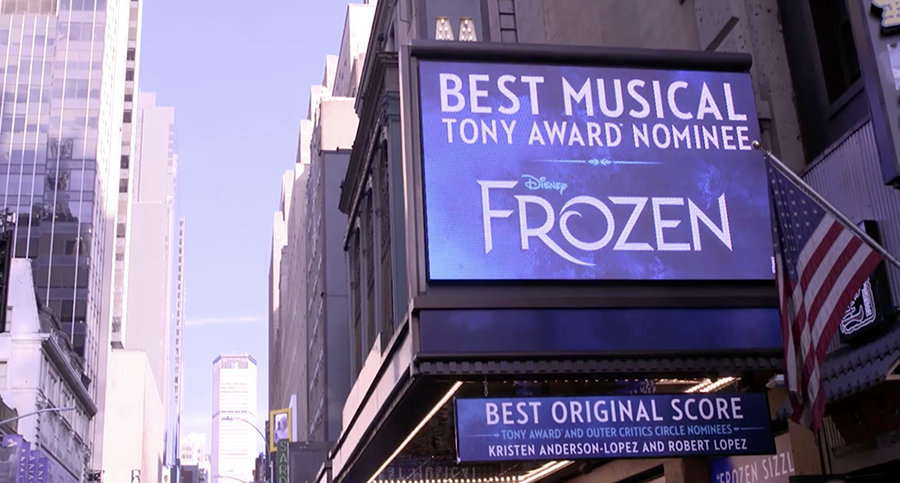
Disney’s newest Broadway show, “Frozen,” is nominated for the Best Musical Tony.
A fast landing
Grandage and Oram’s team retained none of the work from the previous creative team. “It’s a completely blank slate,” Oram says. “I don’t know how far the previous team had gotten, what they’ve done. It was literally just a blank sheet of paper.”
All they had, he says, was the theater and the dates. “The absolute crunch was to deliver a show that would open on the 22nd of March, 2018; we had just over a year, about eighteen months. We parachuted into the process and it was, quite literally, onto a moving avalanche.”
Fortunately, the bosses at Disney didn’t make the time crunch worse by interfering. “The producers were very keen right from the outset about the direction we were going in, so there was never any kind of questioning and doubting.”
The pressure, he says, came from within. “The pressure is on yourself. I know how to design shows—it’s just that this is the big one, the complicated one. I knew I had to deliver, for the audience, a version of that film that they so loved, because I would be angry if I didn’t.”
He began with a trip to Norway to soak up design principles for the sets and costumes. “It was actually a trip that the animators had made five years previously,” he says, “when they were making the movie. We literally followed in their footsteps. We went to the same churches and the same fjords.
“But we look at it with different eyes; we re-purposed it for the stage, as opposed to for a movie. Norway is a very ancient country, and it suffers extreme weather conditions every year. So the wood is very, very weathered, and the timbers are all kind of warped and twisted and old. So that was a stepping-off point for how our world looks: the palace, the castle, the kind of heaviness of the timber.”

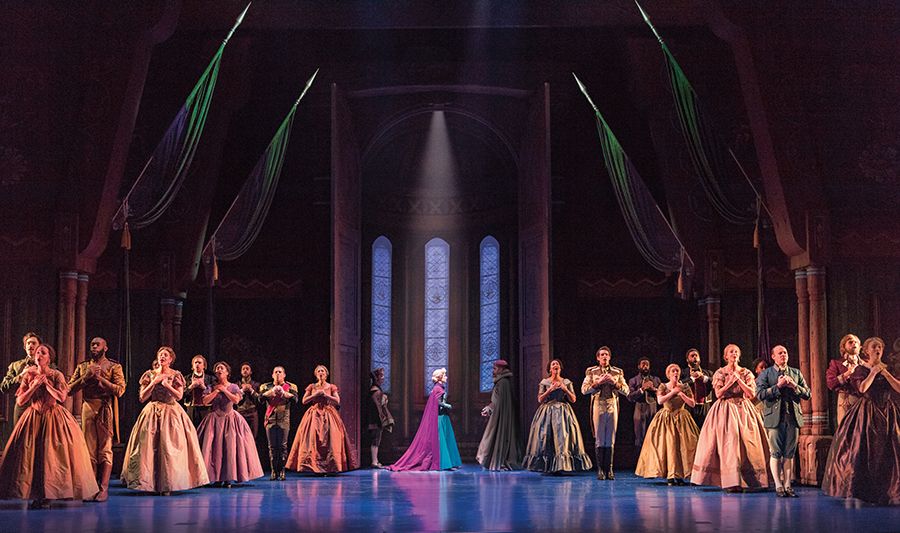
The “Frozen” set is modeled on actual Norwegian landscapes and architecture. (Photo: Deen van Meer)
Magic through technology
Every time Disney adapts an animated movie for the stage — which it had previously done with “The Lion King,” “Beauty and the Beast,” “Tarzan,” “The Little Mermaid,” and “Aladdin” — it faces a challenge. How do you transform the work of animators, who are free to depict anything, to a live stage?
In “Frozen,” technology is behind most of it. Almost none of the effects in the Broadway show would have been technologically possible even five years ago.
“I mean, scenery remains scenery, but the video and the lighting equipment is changing so fast. Even by the time we take the show to London, the video technology we use here will almost be obsolete. It moves that rapidly.”
According to stage manager Lisa Dawn Cave, that technology includes an enormous video screen that forms the back wall of the stage. “Our video wall weighs about 8,600 pounds and contains more than 7 million individual LEDs,” she says.

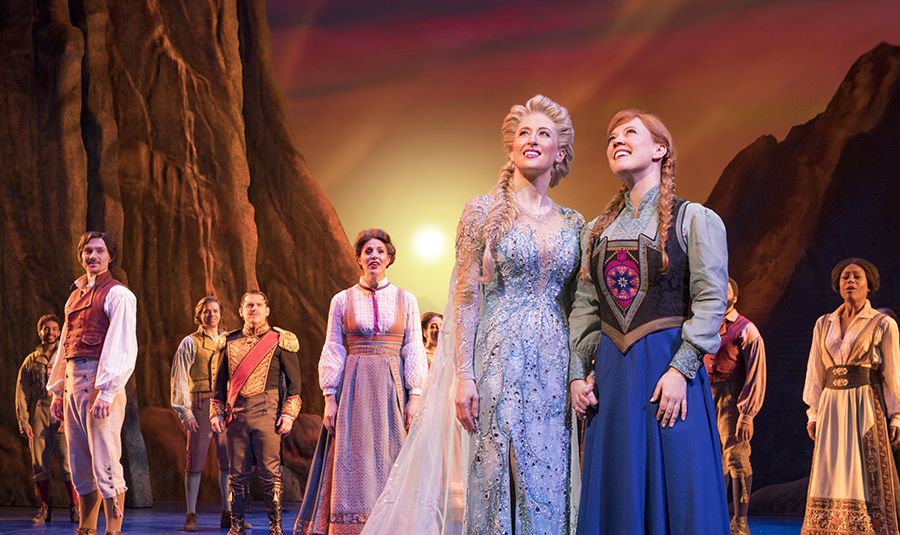
The 7-million-LED video wall provides a huge part of the “Frozen” scenery. (Photo: Deen van Meer)
It’s complemented by 19 projectors — six over the stage, and 13 on the ceiling of the theater, on the balcony railing, and on the box seats. “They’re laser projectors — not lasers in the sense like you see laser beams in movies,” says show electrician Asher Robinson, “but they have a laser phosphor source, which means that we’re not changing the lamps in them, and they’re not making a lot of heat.”

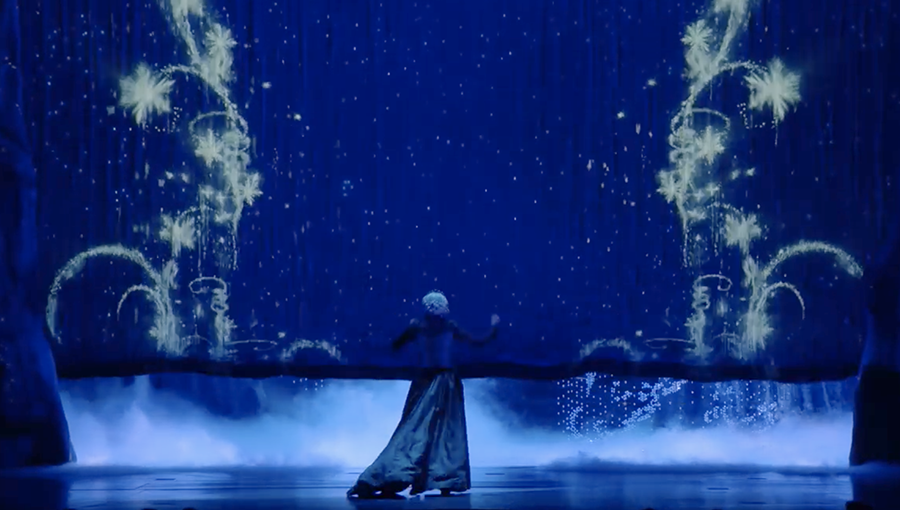
Much of the magic comes from animated projections.
These elaborate projections are controlled by 32 computers, housed in what looks like an enormous data center in the storage area beneath the stage. “There are computers that are just in charge of the LED back wall, there’s a group of eight computers that just do all the LEDs inside the scenery, and there’s a group of nine computers that hold all of the media files, all the movie files, and the projected images,” Robinson says.

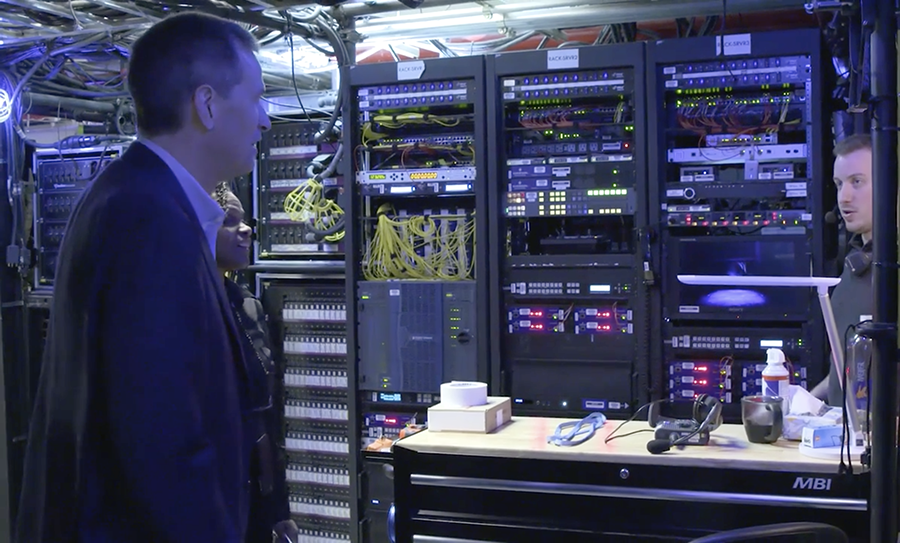
32 computers drive the projectors, videos, and lights.
All of this is designed to work together. “That, I hope, is what we’ve achieved with the visual look of the show,” Oram says. “You’re not really clear where the video starts and the scenery ends, what’s video lighting or what’s technical lighting.”
Case in point: The four stage-height mountain walls that glide in from the wings when, for example, magical ice queen Elsa freezes the town of Arendelle. Video projections from the front animate their transformation into ice—and another million LEDs’ worth of shimmer comes from light panels on the back of these massive translucent panels.

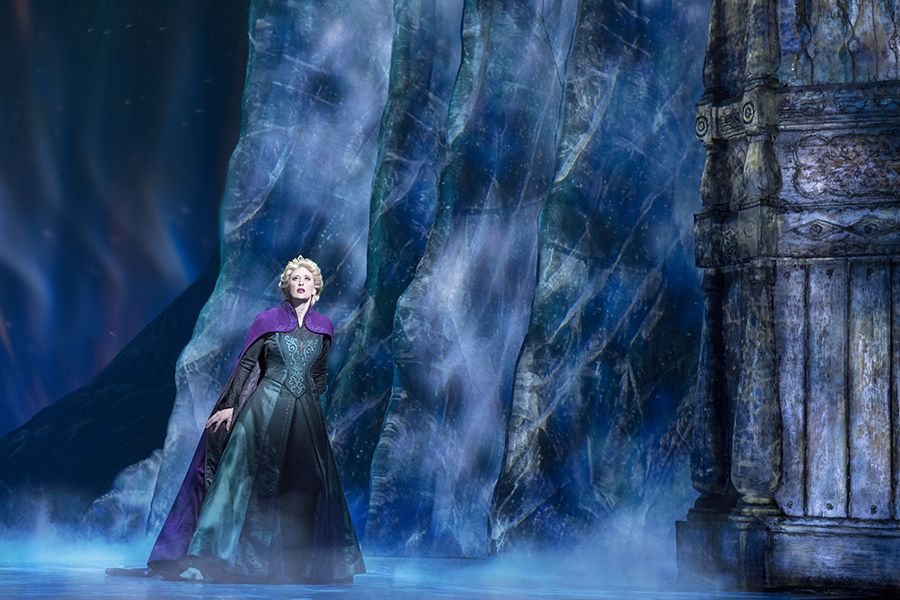
The “ice legs” are illuminated from both the back and the front to create an icy look. (Photo: Deen van Meer)
Oram went to great pains to make all of “Frozen”’s snow and ice effects different. “It was very key to make sure the evening wasn’t just blue all the way through it. Elsa’s magic, for example, has “a very specific and deliberate vocabulary. When she’s happy, the [ice effects] are curvaceous and pretty and decorative and floral. When she’s angry, it’s spiky and hard and aggressive. You never see the same thing twice.”
Character design
Some of Oram’s greatest challenges were creating live versions of elements like these from the animated movie:
- Olaf the snowman. In the movie, Olaf is made of three snowballs that frequently fall apart and then reassemble. Oram worked with longtime Disney puppet designer Michael Carey to create Olaf as a giant marionette, operated and voiced by an actor in full view of the audience. (At one point, he really does make Olaf’s segments fly apart and back together.)


Olaf is puppeteered and voiced by Greg Hildreth.
- Sven the reindeer. “Sven is a kind of different character from the movie,” Oram says. “In the movie, he’s much more puppyish, with all the eye-rolling and tongue-lolling; here, he’s a much more noble creature.” Sven’s costume contains an actor who’s bent over with hand stilts and foot stilts, a job that Oram says is “tough—very tough.” Backstage, the actor is given every possible relief. “The minute he’s off stage, he’s rested and watered and fed. But he’s a very hardworking guy.”


Sven the reindeer is a very fit guy in a suit. (Two actors alternate.)
- The ice shards. Late in the movie, Elsa’s ice castle is infiltrated by angry townsmen who want to capture her. She defends her space by zapping ice walls into existence around them. The Broadway version involves 15 gigantic, transparent, glowing ice shards that shoot upward from beneath the stage, through the double turntable that forms the stage floor (a massive rotating ring surrounding a massive rotating center). “That’s one of my favorites,” says stage manager Cave. “[The ice shards] can go single or they can go all at the same time; we’ve choreographed them to do both. And they also spin! Once they’re up, this outer turntable will spin, and all the men are in the center of the turntable as if they are trapped.”


15 ice shards plunge upward from beneath the stage to trap Elsa’s pursuers.
- The dress change. In the movie, the hit song “Let It Go” is Elsa’s dramatic declaration of independence. At the critical musical moment, her conservative dress transforms into a frosty, glittering ice gown. In the musical, the effect is astonishing: you see Elsa’s dark dress instantly vanish, replaced by the sleek ice dress, in full view, in a flash of a second. How do they do it? “I can’t possibly tell you,” Oram says. “But what I can tell you is that because Caissie [Levy, who plays Elsa], is so beautiful and so slim and gorgeous, you don’t for one minute realize that she’s rigged in all sorts of ways order for it to happen. And she’s singing the big number, and she’s ending the act. It’s a big ask.”


One-tenth of a second ago, Elsa was wearing a totally different outfit.
The pants
Much has been made online about the decision to change Elsa’s second-act costume from a dress (in the movie) to pants (in the musical).
“An animated character can run in a certain way,” he explains. “You can walk backwards in a cape in an animated movie, because the cape can be magically pushed out of the way. But you can’t do that in real life. And that was the direct lineage to putting Elsa in pants in Act 2, and so that you can do the physical action of [running from the mob through the mountains] — in an empowered way, rather than toting around in heels not looking right.”
Curtain call
Oram and Grandage have put together many Shakespeare productions, a lot of London theater, but nothing as giant and commercial as a tentpole Disney Broadway show.
“I don’t think there is anything else this giant and commercial,” Oram acknowledges. “It’s unprecedented in anticipation and scale. The thing was not to be intimidated from the word go. This opportunity comes along literally once your life; I was never going to say no.”
Despite the crashed timeline, Oram is happy with the results. “We’ve changed a lot since we started —we literally re-wrote the opening and re-wrote the ending — but ultimately, we knew where we were going. We had the road map. We had the great numbers that the Lopezes [composer Bobby Lopez and his wife, lyricist Kristen Anderson-Lopez] had written for the film, and then these 12 brilliant new songs they’d written for the Broadway version… It’s been an amazing project—the proper fulfillment of a dream.”
David Pogue, tech columnist for Yahoo Finance, welcomes non-toxic comments in the Comments below. On the web, he’s davidpogue.com. On Twitter, he’s @pogue. On email, he’s poguester@yahoo.com. You can sign up to get his stuff by email, here.
Read more:
Website: LINK
Schreibe einen Kommentar
Du musst angemeldet sein, um einen Kommentar abzugeben.